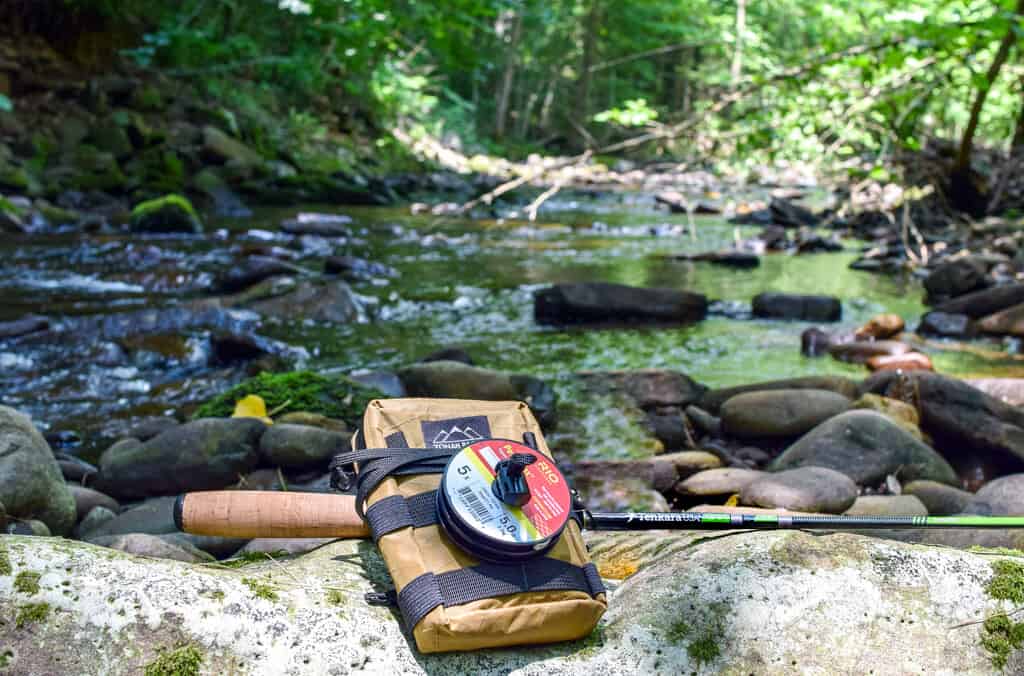Written by Brad Trumbo
Dust billowed as my buddy Derek and I traveled an old gravel road through western Augusta County, Virginia. An interesting feature of many streams draining the George Washington National Forest is the myriad small flood control reservoirs which sever wild brook trout streams, isolating populations to the extreme headwaters in many cases. The water behind one such reservoir was our destination.
Many of these reservoirs are well known and stocked with hatchery trout, our destination included. Yet, the volume of fishermen that frequent this reservoir scarcely acknowledges the disguised trailhead leading into one of Appalachia’s wild brook trout strongholds.
Parking under a canopy of sycamore and maple, a lush carpet of jewelweed and poison ivy greeted us, the trail barely noticeable through the greenery. Embarking on the short hike to the river, we immediately noticed brookies darting for cover as we tramped across a shallow riffle. “It’s gonna be a good day!” I remarked, smugly.
We never fish the trailhead waters, rather hike a short piece before picking our way through the dense floodplain vegetation to a more secluded reach of this small stream. Emerging above a steep cut bank with a nice run rolling along its toe, we crouched carefully alongside a downed log to rig up in concealment.

Derek graciously offered me first cast; a true gentleman honoring his friend’s rare opportunity to fish our home waters. Crawling to the edge and peering cautiously over, my Tenkara USA Rhodo collapsed to its shortest length of 8’-9”, I flipped a size 12 elk hair caddis with an olive body into the head of the run. Instantaneously, a fish rocketed from behind a boulder, trouncing the fly, but I botched the hookset. “Biggest fish of the day, right there.” I mumbled to Derek as the 10-inch wild brookie returned to its position behind the boulder.
Moving upstream and adjusting the Rhodo to 9’-9”, I set my sights on a bedrock run where the stream dropped over solid granite into a slick the size of a swimming pool. The water was incredibly low for June, resembling the trickle of early fall. The pools were glass-flat and gin clear, compelling us to endure a painful crawl across jagged, dry streambed to avoid spooking fish.
An algae-stained granite slab angled into the stream, forcing the flow to the far bank. My knees made soothing purchase on a jade mat of soft moss, and a gentle cast landed the caddis at the head of the cascade feeding the marvelous emerald pool. It bobbed through a narrow cut between the granite slabs, rounded a boulder and was met with an eruption which produced my first fish of the morning.
With the rod stuck high, I guided the eight-inch fish to shore and photographed its varied hues. The rosy speckles with the sapphire halo, the worm-like striations across its back and the fiery glow of the crimson belly tugged at my soul.
Climbing the watershed and picking fish from pockets led to increasingly skinny water. Small channel braids and tight overhead cover began to strain our casting ability, but the fish only became more aggressive, coming often from eddies and flow seams. Typical brook trout fishing, small stream tenkara fishing well suited for the Rhodo.
Collapsing back to 8’-9” allowed for casting under cover, while extending to 10’-6” I was able to reach across boulders and debris while remaining hidden. Crucial features for vegetation-cloaked eastern trout streams that frequently dry to subsurface flow over large reaches during drought conditions.
A blue line slicing through the George Washington National Forest is nearly guaranteed to hold wild trout eager to take an elk hair caddis, aptly-sized Adams or your favorite kebari, and fishing can be hot on all but the most bitter winter days. Expect to crawl, crouch and hide to place your fly in just the right spot; an Appalachian gem to show for the effort. A tenkara rod, a couple flies and the company of a good friend make fishing elsewhere scarcely better.
Author Bio: Brad Trumbo is a biologist and outdoor writer located in southeast Washington State where he and his wife work their small homestead with their pack of Llewellin setters.
Photo Credits: Some photos were taken by Brad Trumbo.
